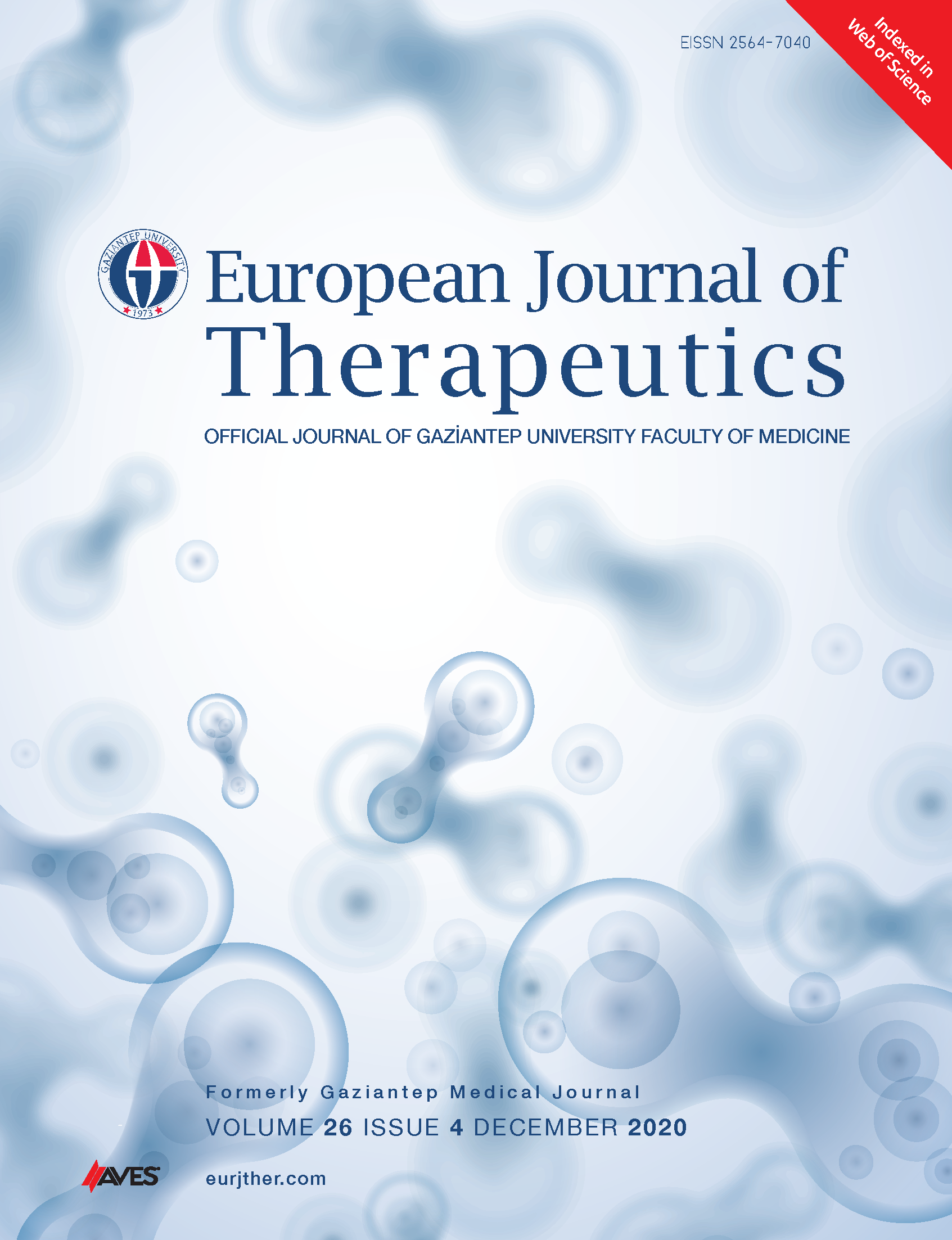Investigation of the Distribution of Orthodontic Anomalies Among Patients in the Eastern Anatolia Region
DOI:
https://doi.org/10.5152/eurjther.2020.20008Keywords:
Orthodontic anomaly, Angle’s classification, crowding, prevalence, Turkish populationAbstract
Objective: This study aimed to identify dental anomalies according to Angle’s classification, skeletal anomalies according to Steiner’s classification, and crowding regions in 2145 patients who presented for consultation at the Department of Orthodontics in the Faculty of Dentistry at Fırat University and to determine the distribution of orthodontic anomalies in the Eastern Anatolia Region.
Methods: In this study, anamnesis forms based on the radiographic and clinical examinations of 2145 patients with ages ranging from 6 to 29 years and who applied at the University were were evaluated their skeletal anomalies were classified according to Steiner’s classification and dental anomalies were classified according to Angle’s classification.
Results: Of the 2145 patients, 373 (64%) were women and 772 (36%) were men. For skeletal anomaly classification, anomalies in 1377 (64.2%) patients were classified as Class I, 569 (26.5%) as Class II, and 199 (9.3%) as Class III. For dental anomaly classification, anomalies in 957 (44.6%) patients were classified as Class I, 962 (44.8%) as Class II, and 226 (10.5%) as Class III. The distributions of these anomalies were also investigated in terms of age, sex, and crowding region.
Conclusion: In this sample of the Turkish population consisting of orthodontics patients in the Eastern Anatolia Region, statistically significant differences were observed in terms of age–skeletal and age–dental anomalies.
Metrics
References
Graber T. Orthodontics, Principle and Practice. 3rd ed. Philadelphia: WB Saunders Company; 1966.
Moyers R. Handbook of Orthodontics. 4th ed. Chicago: Year Book Medical Publishers; 1988.
Asbell MB. A brief history of orthodontics. Am J Orthod Dentofac Orthop 1990; 98: 176-83.
Garner L, Butt M. Malocclusion in black Americans and Nyeri Kenyans: an epidemiologic study. Angle Orthod 1985; 55: 139-46.
Laine T, Hausen H. Occlusal anomalies in Finnish students related to age, sex, absent permanent teeth and orthodontic treatment. Eur J Orthod 1983; 5: 125-31.
Salzmann J. Malocclusion and treatment need in United States youths 12 to 17 years of age. Am J Orthod 1977; 72: 579-81.
Sputh FL. An assessment of malocclusion in caucasian eighth graders in the Indianapolis public school system. Am J Orthod 1982; 82: 84.
Ackerman JL, Proffit WR. The characteristics of malocclusion: a modern approach to classification and diagnosis. Am J Orthod 1969; 56: 443-54.
Diagne F, Ba I, Ba‐Diop K, Yam AA, Ba‐Tamba A. Prevalence of malocclusion in Senegal. Community Dent Oral Epidemiol 1993; 21: 325-6.
Krzypow AB, Lieberaian MA, Modan M. Prevalence of malocclusion in young adults of various ethnic backgrounds in Israel. J Dent Res 1975; 54: 605-8.
Lew K, Foong W, Loh E. Malocclusion prevalence in an ethnic Chinese population. Aust Dent J 1993; 38: 442-9.
Massler M, Frankel JM. Prevalence of malocclusion in children aged 14 to 18 years. Am J Orthod Dentofac Orthop 1951; 37: 751-68.
Tang EL. The prevalence of malocclusion amongst Hong Kong male dental students. Br J Orthod 1994; 21: 57-63.
Wood BF. Malocclusion in the modern Alaskan Eskimo. Am J Orthod 1971; 60: 344-54.
Johnson M, Harkness M. Prevalence of malocclusion and orthodontic treatment need in 10-year-old New Zealand children. Aust Orthod J 2000; 16: 1-8.
Lauc T. Orofacial analysis on the Adriatic islands: an epidemiological study of malocclusions on Hvar Island. Eur J Orthod 2003; 25: 273-8.
Silva RG, Kang DS. Prevalence of malocclusion among Latino adolescents. Am J Orthod Dentofac Orthop 2001; 119: 313-5.
Thilander B, Pena L, Infante C, Parada SS, de Mayorga C. Prevalence of malocclusion and orthodontic treatment need in children and adolescents in Bogota, Colombia. An epidemiological study related to different stages of dental development. Eur J Orthod 2001; 23: 153-68.
Jones WB. Malocclusion and facial types in a group of Saudi Arabian patients referred for orthodontic treatment: a preliminary study. Br J Orthod 1987; 14: 143-6.
Yang W. The study on the orthodontic patients who visited department of orthodontics, Seoul National University Hospital. Taehan Ch’ikkwa Uisa Hyophoe Chi 1990; 28: 811-21.
Baume LJ. Uniform methods for the epidemiologic assessment of malocclusion: results obtained with the World Health Organization standard methods (1962 and 1971) in South Pacific populations. Am J Orthod 1974; 66: 251-72.
Tang EL, Wei SH. Recording and measuring malocclusion: a review of the literature. Am J Orthod Dentofac Orthop 1993; 103: 344-51.
Gravely J, Johnson D. Angle’s classification of malocclusion: an assessment of reliability. Br J Orthod 1974; 1: 79-86.
Sari Z, Uysal T, Karaman A, Basciftci F, Usumez S, Demir A. Orthodontic malocclusions and evaluation of treatment alternatives: an epidemiologic study. Turk J Orthod 2003; 16: 119-26.
Sayın MO, Turkkahraman H, Atilla AO. Investigation of a patient population who applied for orthodontic treatments. Med J SDU 2005; 12: 23-6
Wilmot JJ, Barber HD, Chou DG, Vig KW. Associations between severity of dentofacial deformity and motivation for orthodontic-orthognathic surgery treatment. Angle Orthod 1993; 63: 283-8.
Downloads
Published
How to Cite
Issue
Section
License
Copyright (c) 2023 European Journal of Therapeutics

This work is licensed under a Creative Commons Attribution-NonCommercial 4.0 International License.
The content of this journal is licensed under a Creative Commons Attribution-NonCommercial 4.0 International License.


















